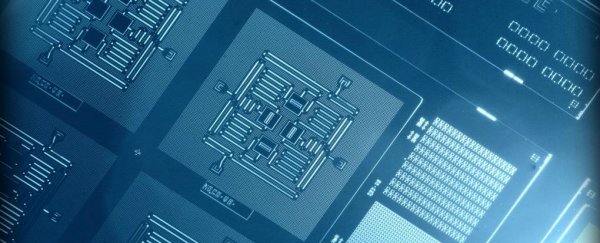Quantum computers have the potential to rapidly sift through huge data stores to solve certain complex problems way faster than their classical counterparts. But before they can be of any practical use, researchers need to be able to detect and fix errors that can occur while transferring data.
Now, a team of researchers at IBM has built a quantum system that's capable of detecting and measuring the two main errors these machines are likely to encounter, overcoming a significant hurdle on the way to developing scalable quantum computers.
"With our recent four-qubit network, we built a system that allows us to detect both types of quantum errors," physicist Jerry Chow, who manages IBM's experimental quantum computing centre in the US, told Jeremy Hsu at IEEE Spectrum.
"This is the first demonstration of a system that has the ability to detect both bit-flip errors and phase errors."
Classical computers understand information as bits, which carry a value of either 1 or 0. But in quantum computers, the main data components are single atoms known as qubits.
They represent the 0 and 1 of binary code, but by leveraging a strange phenomenon known as quantum superposition, they can exist in both states simultaneously. This gives rise to the potential of quantum computers to make certain calculations exponentially faster than classical computers, but it also gives rise to a broader spectrum of technical difficulties.
Classical computers are only subject to bit-flip errors - when bits change values due to noise or interference. These can be corrected relatively easily by copying the same bit repeatedly, and then taking the correct value from the majority, writes Hsu.
Quantum computers can experience these errors, but are also vulnerable to another problem known as a 'phase error', which flips the sign of the phase relationship between 0 and 1 in a superposition state. Detecting and correcting these errors in quantum systems is extremely challenging because the information, which essentially lives on the spin of an atomic particle, is fragile and short-lived, and can be disrupted when it interacts with any type of matter or radiation.
Until now, it was only possible to address one type of quantum error or the other at a given time, but never both. And for quantum computers to work this is imperative.
The IBM researchers were able to detect and measure both errors by relying on the phenomenon known as entanglement, by which qubits can nearly instantaneously share information with other qubits.
IBM's device, which is described in the latest edition of Nature Communications, involved a square architecture of four qubits. Two of these represented data qubits, while the other two served a measurement function. Each of the measurement qubits was able identify bit and phase errors occurring between the data qubits, respectively.
The next step is to develop a scaled up system with more qubits that can not only identify errors, but solve them.
Earlier this year, another research team funded by Google reported in Nature the development of a linear array of qubits that was able to identify and correct errors. But importantly, as Hsu points out for IEEE Spectrum, this system could not detect and correct both errors at the same time.
The IBM team, which has been using standard silicon fabrication techniques, believes it will be easier to scale up their device. In the company press release, IBM says it "anticipates that once a handful of superconducting qubits can be manufactured reliably and repeatedly, and controlled with low error rates, there will be no fundamental obstacle to demonstrating error correction in larger lattices of qubits."
While they're likely some way off, and aren't going to make your laptop any faster, quantum computers - once realised - will have a profound impact on a number of research areas. Right now, it's believed they'll be useful in the design of new super materials and drugs, but in the future, it's possible that all kinds of new applications we haven't yet pondered could open up.
